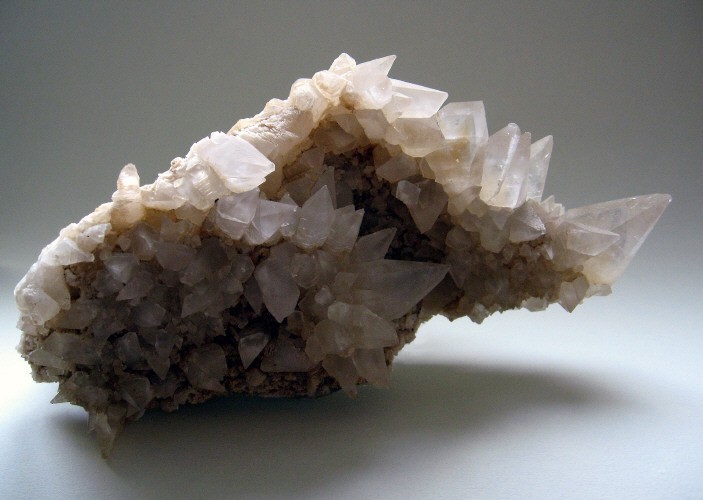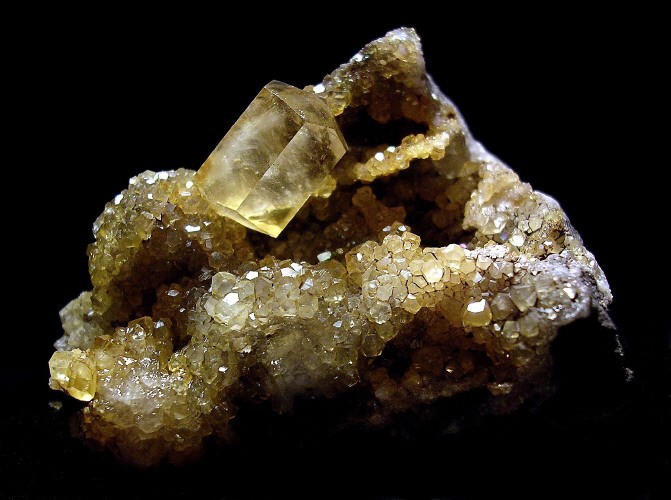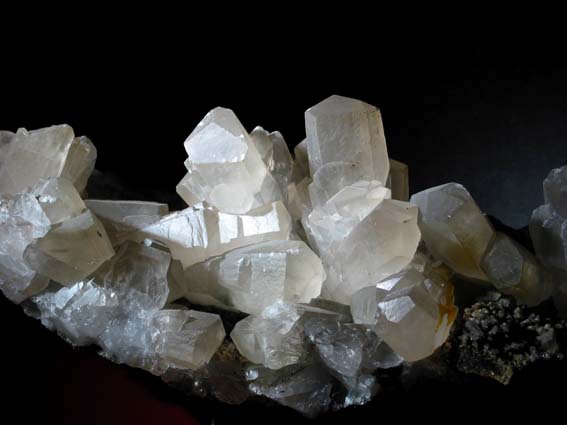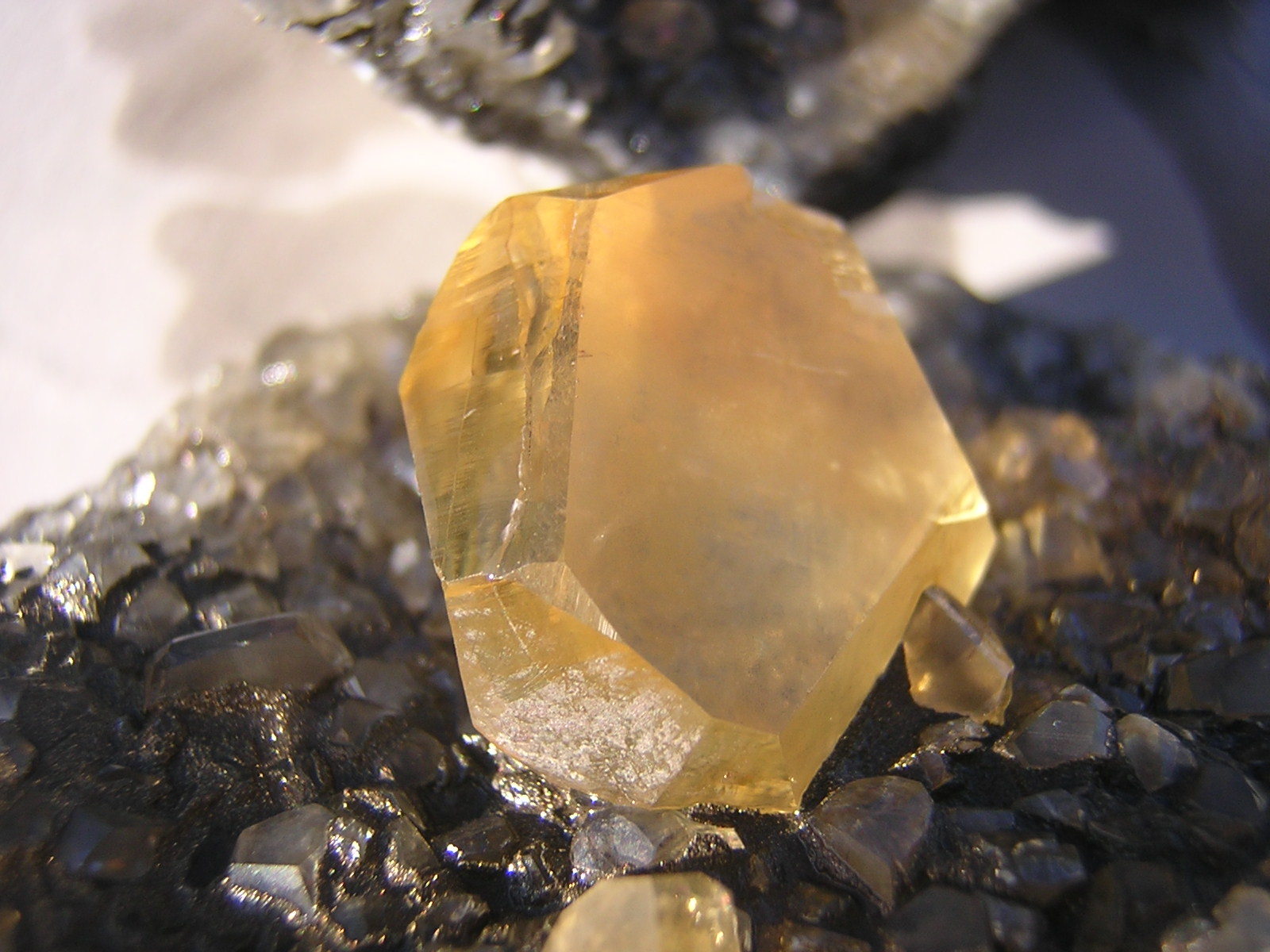Belgium, Calcite paradise
Last Updated: 16th Mar 2009By Harjo Neutkens
Belgium, Calcite paradise
The mountainous regions of Belgium (mainly south of the Sambre and Meuse rivers) consist for the greater part of Limestone plateaus.
Although there are other types of geologic environments in Belgium, for example the metamorphic rocks encountered in several ereas of the Ardennes mountains and the eruptive rock in the Hainaut province where Calcite crystals have been found, the mainstay of Belgian Calcite specimens are being found in Devonian and Dinantian Limestone.
For ages Belgian Limestone has been exploited in quarries, nowadays mainly for building purposes like road construction, ornamental stones and concrete but also for the glass, food and chemical industries.
From the middle ages onwards (and probably even earlier) Belgium also has been a prime source for marble, actually it’s not a genuine marble but a dense and hard limestone that shows very appealing ornamental patterns.
Especially the red “marble” found around Rochefort and the black “marble” encountered around Yvoir where in high demand and got exported throughout Europe (the word goes that there’s Belgian marble in St Peter‘s church in Rome)
Calcite from the Dinantian Limestone
The Dinantian Limestone has been very rich in world class localities for Calcite, and to a certain extend remains as such.
In Biesmeree, Bioul, Denee and Haut-le-Wastia Calcite crystals (mainly scalenohedral habits) have been found that rival any in the world.
Calcite
Biesmerée
Mettet, Namur Province, Belgium
Calcite
Haut-le-Wastia
Anhée, Namur Province, Belgium
A vug with a very large scalenohedron in Haut-le-Wastia I worked in 2007
Haut-le-Wastia quarry in 2007
Sadly most of the quarrying operations have ceased their operations and only the quarry in Haut-le-Wastia shows some sporadic activity.
A little bit to the east, north of Dinant (the birthplace of Adolphe Sax, inventor of the saxophone!) there are several quarries.
Close to the abbey of Leffe (famous for it’s trappist beer) lies the Montorguill quarry, from there exceptionally large Calcites up to 40cm have been found in scalenohedral as well as rhombohedral habits, the quarry remains in operation and is run by the Gralex company.
Calcite
Montorgueil Quarry (Leffe Quarry)
Dinant, Namur Province, Belgium
A little to the north some active quarries remain exploiting the dark compact limestone around the town of Yvoir.
The so called “Pierre Bleu” or “blackstone” is used for ornamental use.
Due to the compact nature of the rock very little cavities are encountered and when so they are usually very small, therefore the Calcites found in them are quite small but nevertheless very attractive.
To the north-east from Yvoir the Pierre Bleu zone continues almost to Liege, especially around the townships of Sprimont and Chanxhe there remain several active quarries that exploite the Pierre Bleu for ornamental stones, the coarser limestone encountered alongside the Pierre Bleu yields gravel as a by-product.
Calcite
Chanxhe quarry
Sprimont, Liège Province, Belgium
Large vug in Chanxhe quarry, my head for scale ;-) photo by Frank de Wit
To the west we encounter the town of Charleroi, a large somewhat decaying centre for mainly steel industry which flourished in the 19th and first halve of the 20th centuries but rapidly declined since the 1950s creating a large unemployed population, remaining so to this day.
Around Charleroi there are several active quarries and a multitude of closed ones.
Some of the best Calcites in the world (in my humble opinion…) came from two quarries that are situated closely together a couple of miles west of Charleroi.
One of them, the “la Sambre” quarry on the banks of the Sambre river in Landelies remains active whereas the other one, the Gralex quarry in Mont-sur-Marchienne ceased it’s operations about ten years ago.
The limestone in these two quarries is very pure and therefore very suitable for use in the glass, chemical and nutrition industries as well as for agricultural purposes.
In these quarries Calcites have been found in an extremely large variety of forms and habits, the crystals can be up to 20cm large and the colour ranges from colourless, yellow, orange, amber to dark brown.
In 2008 Calcite crystals could be found that showed a very distinct and appealing olive green colour, they remain a rarity.
Calcite
La Sambre Quarry
Landelies, Montignies-le-Tilleul, Hainaut (Henegouwen; Hennegau) Province, Belgium
La Sambre quarry in winter 2009
Calcite
Gralex Quarry
Mont-sur-Marchienne, Charleroi, Hainaut (Henegouwen; Hennegau) Province, Belgium
Large pieces with big scalenohedrons as well as beautiful clear twins have been collected during the time when the Solvay quarry (a little south of Charleroi, between the townships of Loverval and Couillet) was still in operation.
Close to the town of Namur one also finds several quarries, the best Calcites of that area came from the Gralex quarry of Beez, although the quality of these nice scalenohedrons found in the 1980s has not been surpassed since.
Calcite
Beez
Namur, Namur Province, Belgium
Nice Calcites have also been found in the quarries of Sclayn and Maizeret both situated between Namur and Liege.
The Devonian Limestone
South of the Meuse river there is a large Devonian limestone plateau covering the Fagne and Famenne regions.
Especially nice Calcites have been found in the so called “Calestienne” region which covers a part of the Fagne and Famenne between the provincial towns of Rochefort (again famous for it’s trappist beer!) in the east , Couvin in the west and Givet (on the border with France) to the south.
The Calestienne region is very rich in Pb, Zn, Cu, Fe and Fluorite deposits and all of these have been exploited over the ages.
Nowadays the only exploitation is done on Limestone for building purposes.
Very nice Calcite crystals have (sporadically) come out of the quarries around the small village of Wellin, about ten km west of Rochefort.
Two quarries that are located only a mile apart from each other remain in operation, one of them, the “Fond des Vaulx” quarry can be visited after applying for an authorisation, the other one, the “Limites” quarry is closed for mineral collecting and therefore should not be visited.
Not surprisingly the two quarries show a similar paragenesis.
In 2005 they worked a zone with exceptionally large Brachiopod fossils that contained splendid lustrous colourless calcite crystals very reminiscent to the old specimens found in Cumberland.
Notable minerals that accompany the Calcites are especially Fluorite (in highly lustrous purple, yellow and sometimes green crystals), Celestine, Sphalerite and Marcasite.
Calcite
Fond des Vaulx quarry
Wellin, Luxembourg Province, Belgium
Fond des Vaulx quarry in 2007
Quite close to Wellin, on the banks of the Lesse river, we find the now closed quarry of Resteigne, from there abundant and very nice Calcite appeared as well over the years.
Calcite
La Lesse Quarry
Resteigne, Tellin, Luxembourg Province, Belgium
View from la Lesse quarry towards the chateau
Apart from the outstanding localities mentioned above some nice Calcite specimens occasionally came out of some other localities, I won’t mention them all but some should be noted.
In Engis, close to the town of Liege, very nicely formed Calcites where found in an array of forms.
Also Rhisnes produced nice Calcite in the past.
Around Antoing very large quarries sometimes deliver large scalenohedrons and honey coloured rhombohedral crystals.
Calcite
Antoing
Tournai (Doornijk), Hainaut (Henegouwen; Hennegau) Province, Belgium
During the mining operations around Moresnet-Vielle Montagne abundant Calcite has been found although the dominant carbonate there was Smithsonite (and is famous for that mineral)
Interesting internet resources on Belgian Calcite:
-Jose Dehove's site: http://perso.infonie.be/jose.dehove/photos/index.htm
-Jean-Marc Jonville's site: http://www.calcite.be/
-Luc van Bellingen's site: http://www.fossiliraptor.be/
-Michel Blondieau's site: http://membres.lycos.fr/minbe/
-Marc Henrotin's site: http://users.skynet.be/belgafossmine/
-Jacques Evlard's site: http://www.artistones1.be/chapitres/collection_j_evlard/calcite/liste_belgique.htm
-Ingo Loeffler's site: http://www.the-crystalminer.com/
-CMPB (the Brussels mineral club): http://www.cmpb.net/
-Strahlen.org: http://www.strahlen.org/
Epilogue
But probably the best thing about prospecting for world class Calcite specimens in Belgium is that one can combine that with drinking the world famous Belgian beer!
Hundreds of Belgian beers!!: http://nl.wikipedia.org/wiki/Lijst_van_Belgische_bieren
Harjo Neutkens (c) 2009
The mountainous regions of Belgium (mainly south of the Sambre and Meuse rivers) consist for the greater part of Limestone plateaus.
Although there are other types of geologic environments in Belgium, for example the metamorphic rocks encountered in several ereas of the Ardennes mountains and the eruptive rock in the Hainaut province where Calcite crystals have been found, the mainstay of Belgian Calcite specimens are being found in Devonian and Dinantian Limestone.
For ages Belgian Limestone has been exploited in quarries, nowadays mainly for building purposes like road construction, ornamental stones and concrete but also for the glass, food and chemical industries.
From the middle ages onwards (and probably even earlier) Belgium also has been a prime source for marble, actually it’s not a genuine marble but a dense and hard limestone that shows very appealing ornamental patterns.
Especially the red “marble” found around Rochefort and the black “marble” encountered around Yvoir where in high demand and got exported throughout Europe (the word goes that there’s Belgian marble in St Peter‘s church in Rome)
Calcite from the Dinantian Limestone
The Dinantian Limestone has been very rich in world class localities for Calcite, and to a certain extend remains as such.
In Biesmeree, Bioul, Denee and Haut-le-Wastia Calcite crystals (mainly scalenohedral habits) have been found that rival any in the world.
Calcite
Biesmerée
Mettet, Namur Province, Belgium
Calcite
Haut-le-Wastia
Anhée, Namur Province, Belgium
A vug with a very large scalenohedron in Haut-le-Wastia I worked in 2007
Haut-le-Wastia quarry in 2007
Sadly most of the quarrying operations have ceased their operations and only the quarry in Haut-le-Wastia shows some sporadic activity.
A little bit to the east, north of Dinant (the birthplace of Adolphe Sax, inventor of the saxophone!) there are several quarries.
Close to the abbey of Leffe (famous for it’s trappist beer) lies the Montorguill quarry, from there exceptionally large Calcites up to 40cm have been found in scalenohedral as well as rhombohedral habits, the quarry remains in operation and is run by the Gralex company.
Calcite
Montorgueil Quarry (Leffe Quarry)
Dinant, Namur Province, Belgium
A little to the north some active quarries remain exploiting the dark compact limestone around the town of Yvoir.
The so called “Pierre Bleu” or “blackstone” is used for ornamental use.
Due to the compact nature of the rock very little cavities are encountered and when so they are usually very small, therefore the Calcites found in them are quite small but nevertheless very attractive.
To the north-east from Yvoir the Pierre Bleu zone continues almost to Liege, especially around the townships of Sprimont and Chanxhe there remain several active quarries that exploite the Pierre Bleu for ornamental stones, the coarser limestone encountered alongside the Pierre Bleu yields gravel as a by-product.
Calcite
Chanxhe quarry
Sprimont, Liège Province, Belgium
Large vug in Chanxhe quarry, my head for scale ;-) photo by Frank de Wit
To the west we encounter the town of Charleroi, a large somewhat decaying centre for mainly steel industry which flourished in the 19th and first halve of the 20th centuries but rapidly declined since the 1950s creating a large unemployed population, remaining so to this day.
Around Charleroi there are several active quarries and a multitude of closed ones.
Some of the best Calcites in the world (in my humble opinion…) came from two quarries that are situated closely together a couple of miles west of Charleroi.
One of them, the “la Sambre” quarry on the banks of the Sambre river in Landelies remains active whereas the other one, the Gralex quarry in Mont-sur-Marchienne ceased it’s operations about ten years ago.
The limestone in these two quarries is very pure and therefore very suitable for use in the glass, chemical and nutrition industries as well as for agricultural purposes.
In these quarries Calcites have been found in an extremely large variety of forms and habits, the crystals can be up to 20cm large and the colour ranges from colourless, yellow, orange, amber to dark brown.
In 2008 Calcite crystals could be found that showed a very distinct and appealing olive green colour, they remain a rarity.
Calcite
La Sambre Quarry
Landelies, Montignies-le-Tilleul, Hainaut (Henegouwen; Hennegau) Province, Belgium
La Sambre quarry in winter 2009
Calcite
Gralex Quarry
Mont-sur-Marchienne, Charleroi, Hainaut (Henegouwen; Hennegau) Province, Belgium
Large pieces with big scalenohedrons as well as beautiful clear twins have been collected during the time when the Solvay quarry (a little south of Charleroi, between the townships of Loverval and Couillet) was still in operation.
Close to the town of Namur one also finds several quarries, the best Calcites of that area came from the Gralex quarry of Beez, although the quality of these nice scalenohedrons found in the 1980s has not been surpassed since.
Calcite
Beez
Namur, Namur Province, Belgium
Nice Calcites have also been found in the quarries of Sclayn and Maizeret both situated between Namur and Liege.
The Devonian Limestone
South of the Meuse river there is a large Devonian limestone plateau covering the Fagne and Famenne regions.
Especially nice Calcites have been found in the so called “Calestienne” region which covers a part of the Fagne and Famenne between the provincial towns of Rochefort (again famous for it’s trappist beer!) in the east , Couvin in the west and Givet (on the border with France) to the south.
The Calestienne region is very rich in Pb, Zn, Cu, Fe and Fluorite deposits and all of these have been exploited over the ages.
Nowadays the only exploitation is done on Limestone for building purposes.
Very nice Calcite crystals have (sporadically) come out of the quarries around the small village of Wellin, about ten km west of Rochefort.
Two quarries that are located only a mile apart from each other remain in operation, one of them, the “Fond des Vaulx” quarry can be visited after applying for an authorisation, the other one, the “Limites” quarry is closed for mineral collecting and therefore should not be visited.
Not surprisingly the two quarries show a similar paragenesis.
In 2005 they worked a zone with exceptionally large Brachiopod fossils that contained splendid lustrous colourless calcite crystals very reminiscent to the old specimens found in Cumberland.
Notable minerals that accompany the Calcites are especially Fluorite (in highly lustrous purple, yellow and sometimes green crystals), Celestine, Sphalerite and Marcasite.
Calcite
Fond des Vaulx quarry
Wellin, Luxembourg Province, Belgium
Fond des Vaulx quarry in 2007
Quite close to Wellin, on the banks of the Lesse river, we find the now closed quarry of Resteigne, from there abundant and very nice Calcite appeared as well over the years.
Calcite
La Lesse Quarry
Resteigne, Tellin, Luxembourg Province, Belgium
View from la Lesse quarry towards the chateau
Apart from the outstanding localities mentioned above some nice Calcite specimens occasionally came out of some other localities, I won’t mention them all but some should be noted.
In Engis, close to the town of Liege, very nicely formed Calcites where found in an array of forms.
Also Rhisnes produced nice Calcite in the past.
Around Antoing very large quarries sometimes deliver large scalenohedrons and honey coloured rhombohedral crystals.
Calcite
Antoing
Tournai (Doornijk), Hainaut (Henegouwen; Hennegau) Province, Belgium
During the mining operations around Moresnet-Vielle Montagne abundant Calcite has been found although the dominant carbonate there was Smithsonite (and is famous for that mineral)
Interesting internet resources on Belgian Calcite:
-Jose Dehove's site: http://perso.infonie.be/jose.dehove/photos/index.htm
-Jean-Marc Jonville's site: http://www.calcite.be/
-Luc van Bellingen's site: http://www.fossiliraptor.be/
-Michel Blondieau's site: http://membres.lycos.fr/minbe/
-Marc Henrotin's site: http://users.skynet.be/belgafossmine/
-Jacques Evlard's site: http://www.artistones1.be/chapitres/collection_j_evlard/calcite/liste_belgique.htm
-Ingo Loeffler's site: http://www.the-crystalminer.com/
-CMPB (the Brussels mineral club): http://www.cmpb.net/
-Strahlen.org: http://www.strahlen.org/
Epilogue
But probably the best thing about prospecting for world class Calcite specimens in Belgium is that one can combine that with drinking the world famous Belgian beer!
Hundreds of Belgian beers!!: http://nl.wikipedia.org/wiki/Lijst_van_Belgische_bieren
Harjo Neutkens (c) 2009
Article has been viewed at least 22493 times.













































Lepoivre quarry, Biesmerée, Mettet, Namur, Wallonia, Belgium